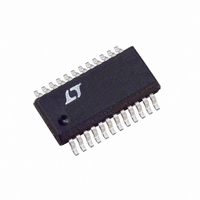LTC1436AIGN-PLL#TR Linear Technology, LTC1436AIGN-PLL#TR Datasheet - Page 22

LTC1436AIGN-PLL#TR
Manufacturer Part Number
LTC1436AIGN-PLL#TR
Description
IC REG SW SYNC STEPDWN LN 24SSOP
Manufacturer
Linear Technology
Type
Step-Down (Buck)r
Datasheet
1.LTC1436AIGN-PLLPBF.pdf
(28 pages)
Specifications of LTC1436AIGN-PLL#TR
Internal Switch(s)
No
Synchronous Rectifier
Yes
Number Of Outputs
1
Voltage - Output
1.19 ~ 9 V
Current - Output
50mA
Frequency - Switching
125kHz ~ 240kHz
Voltage - Input
3.5 ~ 30 V
Operating Temperature
-40°C ~ 85°C
Mounting Type
Surface Mount
Package / Case
24-SSOP
Lead Free Status / RoHS Status
Contains lead / RoHS non-compliant
Power - Output
-
Other names
LTC1436AIGN-PLLTR
Available stocks
Company
Part Number
Manufacturer
Quantity
Price
Part Number:
LTC1436AIGN-PLL#TRLTC1436AIGN-PLL
Manufacturer:
Linear Technology
Quantity:
135
APPLICATIONS
LTC1436A
LTC1436-PLL-A/LTC1437A
A second, more severe transient is caused by switching in
loads with large (>1µF) supply bypass capacitors. The
discharged bypass capacitors are effectively put in parallel
with C
deliver enough current to prevent this problem if the load
switch resistance is low and it is driven quickly. The only
solution is to limit the rise time of the switch drive so that
the load rise time is limited to approximately 25(C
Thus a 10µF capacitor would require a 250µs rise time,
limiting the charging current to about 200mA.
Automotive Considerations: Plugging into the
Cigarette Lighter
As battery-powered devices go mobile, there is a natural
interest in plugging into the cigarette lighter in order to
conserve or even recharge battery packs during operation.
But before you connect, be advised: you are plugging into
the supply from hell. The main battery line in an automo-
bile is the source of a number of nasty potential transients,
including load dump, reverse battery, and double battery.
Load dump is the result of a loose battery cable. When the
cable breaks connection, the field collapse in the alternator
can cause a positive spike as high as 60V which takes
several hundred milliseconds to decay. Reverse battery is
just what it says, while double battery is a consequence of
tow-truck operators finding that a 24V jump start cranks
cold engines faster than 12V.
The network shown in Figure 14 is the most straightfor-
ward approach to protect a DC/DC converter from the
ravages of an automotive battery line. The series diode
prevents current from flowing during reverse battery,
while the transient suppressor clamps the input voltage
during load dump. Note that the transient suppressor
22
OUT
12V
Figure 14. Automotive Application Protection
, causing a rapid drop in V
GENERAL INSTRUMENT
TRANSIENT VOLTAGE
SUPPRESSOR
50A I PK RATING
U
1.5KA24A
INFORMATION
U
V
W
OUT
IN
LTC1436A
LTC1437A
. No regulator can
1436 F14
U
LOAD
).
should not conduct during double battery operation, but
must still clamp the input voltage below breakdown of the
converter. Although the LTC1436A/LTC1437A have a maxi-
mum input voltage of 36V, most applications will be
limited to 30V by the MOSFET BV
Design Example
As a design example, assume V
22V (max), V
and C
Refering to Figure 3, a 4.7µH inductor falls within the
recommended range. To check the actual value of the
ripple current the following equation is used:
The highest value of the ripple current occurs at the
maximum input voltage:
The lowest duty cycle also occurs at maximum input
voltage. The on-time during this condition should be
checked to make sure it doesn’t violate the LTC1436A/
LTC1437A’s minimum on-time and cause cycle skipping
to occur. The required on-time at V
The ∆I
43% of I
minimum on-time at 43% ripple is about 235ns. There-
fore, the minimum on-time is sufficient and no cycle
skipping will occur.
R
C
C
∆I
t
ON MIN
OSC
SENSE
OSC
L
OSC
(
L
=
MAX
was previously calculated to be 1.3A, which is
=
( )( )
V
( )
can immediately be calculated:
f L
)
pF
⎛
⎜
⎜
⎝
OUT
=
=
. From Figure 12, the LTC1436A/LTC1437A’s
1 37 10
OUT
100
. (
(
=
⎛
⎜
⎝
V
250
3
1
IN MAX
= 1.6V, I
A
mV
⎡
⎢
⎢
⎣
−
V
(
Frequency kHz
OUT
V
4
V
OUT
=
)
IN
1 37 10
)
⎞
⎟
⎟
⎠
)
0 033
.
( )
MAX
–
⎞
⎟
⎠
.
f
11 43
(
=
= 3A and f = 250kHz, R
=
Ω
(
22
IN
4
( )
)
DSS
= 12V (nominal), V
V
pF
IN(MAX)
)(
1 6
.
.
250
⎤
⎥
⎥
⎦
V
–
kHz
11
is:
)
=
291
SENSE
14367afb
ns
IN
=












